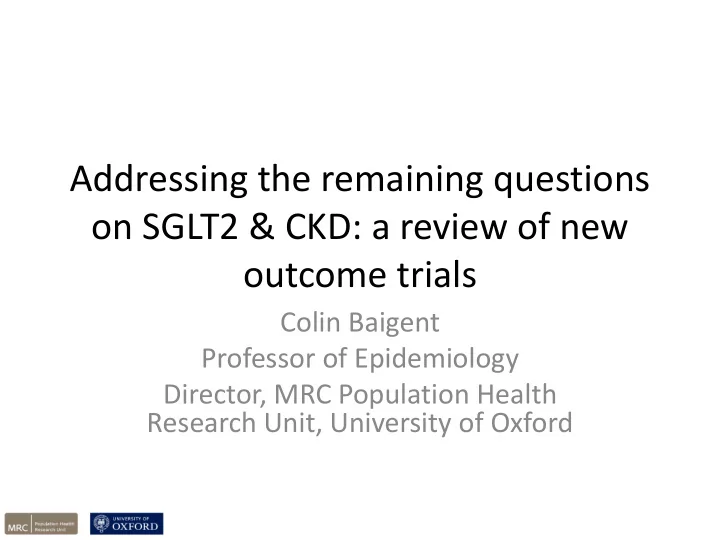

Addressing the remaining questions on SGLT2 & CKD: a review of new outcome trials Colin Baigent Professor of Epidemiology Director, MRC Population Health Research Unit, University of Oxford
DISCLOSURES I am co-chair of the EMPA-KIDNEY trial, which is supported by a grant to the University of Oxford from Boehringer Ingelheim. I do not accept personal payments (including speaker fees, honoraria, stock) from pharmaceutical companies, but I accept reimbursement of expenses arising from attending attending scientific meetings.
Talk outline • What are the questions that need to be addressed before considering SGLT2-inhibition in patients with CKD? • What will the ongoing trials tell us? • Conclusions
What are the questions when considering SGLT2-inhibitors for patients with CKD? • Effects of SGLT2-inhibition as GFR declines
Effects of empagliflozin on 24 hour glycosuria at different levels of eGFR 5 Macha S et al. Diabetes, Obesity and Metabolism 2014;16:215-222
Pooled analysis of phase III trials: Effects of empagliflozin on HbA1c at low eGFR 6 Cherney et al. Kidney Int 2018; 93: 231-244
EMPA-REG OUTCOMES: Effect of Empagliflozin on “CKD” outcomes Time to doubling of creatinine, RRT start or renal death Wanner C et al. N Engl J Med 2016; 375:323-34
What are the questions when considering SGLT2-inhibitors for patients with CKD? • Effects of SGLT2-inhibition as GFR declines • Effects in people without diabetes mellitus
Evidence for effects on glomerular pressure in those without diabetes Overweight otherwise healthy 1 Pre-diabetes or obesity 2 ~12% creatinine clearance ~8% measured GFR 16 ml/min/1.73 m 2 8 ml/min/1.73 m 2 180 140 160 † 140 120 Baseline Baseline mL/min * 120 100 Day 3 Acute 100 80 60 80 * p <0.05 40 † p =NS vs vs baseline 20 baseline 60 0 9 1. Clinical trial report. Trial 1245.66. 2016. Data on file; 2. Ferrannini E et al. Diabetes Care 2017
Key areas of uncertainty about SGLT2-inhibitors in patients with CKD • Efficacy – Effects of SGLT-inhibitors on GFR decline, and especially on ESRD outcomes – Effects on CV outcomes as GFR↓ – Effects on CV and renal endpoints in patients without diabetes • Safety – Magnitude of known adverse effects as GFR↓ – Potential for unanticipated adverse effects in people with eGFR < 45 mL/min/1.73m 2
What will the ongoing trials tell us?
CREDENCE: key design elements Inclusion criteria: – Age ≥30 years (mean=63*) – T2DM, HbA1c 6.5-12% (mean =8.3%*) – eGFR 30-90 mL/min/1.73m 2 (mean =56*) AND uACR 300-5000 mg/g (median=927) – Stable maximally tolerated RAS blockade Sample size: 4401 (actual) Comparison: Canagliflozin 100mg vs. placebo Primary endpoint: Doubling of creatinine, ESKD, or death from renal or CV causes Secondary endpoints: ESRD and CV or renal death; individual components of composite endpoints (2xSCr, renal death, MI, stroke, HF, UA); ∆ eGFR over time; ∆UACR over time * Jardine M et al. Am J Nephrol 2017; 46: 462-72 (design & baseline paper)
DAPA CKD: key design elements Inclusion criteria: – Age ≥18 years – eGFR 25-75 mL/min/1.73m2 AND uACR 200-5000 mg/g – Stable maximally tolerated RAS blockade, if not contraindicated Sample size: ~4000 Comparison: Dapagliflozin 5/10 mg vs. placebo Primary endpoint: Sustained ≥50% decline in eGFR, ESKD, or death from renal or CV causes Secondary endpoints: Renal composite (eGFR, ESRD, or renal death), HF composite (CV death, hospitalisation for HF), all-cause mortality
14
Study eligibility • Age ≥18 years at Screening; • CKD at risk of progression; • The responsible physician(s) judge that empagliflozin (or other SGLT-2 or SGLT-1/2 inhibitor) not part of the current standard of care • Clinically appropriate doses of RAS blockade used unless RAS blockade not tolerated or indicated 15
eGFR inclusion criteria • Local laboratory results recorded ≥3 months before and at Screening: – eGFR ≥20 <45 mL/min/1.73m 2 ; OR – eGFR ≥45 <90 mL/min/1.73m 2 ; AND UACR ≥200 mg/g (or protein:creatinine ratio ≥300 mg/g) • Steering Committee will monitor the numbers of people with an eGFR <45 and ≥45 (and also those with and without diabetes) to ‘fine - tune’ final study population 16
Treatment comparison Follow-up visits at 2 & 6 months, Run-in then 6-monthly until there is a minimum number 8-12 weeks of primary outcome endpoints Empagliflozin 10 mg Screening Confirmation of appropriate Randomization RAS blockade Visit Visit Matching placebo 17
Summary of 3 ongoing trials S18
SGLT2-inhibitor trials in CKD: (1) INCLUSION CRITERIA CREDENCE DAPA-CKD EMPA-KIDNEY Age ≥30 ≥18 ≥18 ≥1/3 DM ≥1/3 DM DM/non-DM T2DM only ≥ 1/3 non-DM ≥ 1/3 non-DM ≥30 <90 (i ) ≥20 <45 OR Renal function 25 – 75 (mean=56.2) (ii) ≥45 <90 with eGFR*/UACR AND ≥ 200mg/g AND >300mg/g ≥200mg/g *mL/min/1.73m 2
SGLT2-inhibitor trials in CKD: (2) PRIMARY ENDPOINTS AND POWER CREDENCE DAPA-CKD EMPA-KIDNEY Sample size 4401 (actual) ~4000 ~5000 2 x SCr, ≥50% ↓ eGFR, ≥40%↓ eGFR, Primary ESKD, ESKD, or ESKD, or endpoint CV or renal death CV or renal death CV or renal death Number of primary 844 ~600* 1070 events required Planned duration ~4 years ~4 years ~3 years of follow-up RRR to be detected 20% N/A 18% Statistical power 90% at p=0.05 N/A 90% at p=0.05 *estimated
SGLT2-inhibitor trials in CKD: (3) SECONDARY ENDPOINTS CREDENCE DAPA-CKD EMPA-KIDNEY ESKD, renal death ≥50%↓ eGFR or Key: or CV death ESKD or renal death HF hospitalisation or CV death Components of composite CV death or HF All cause hospitalisation endpoints hospitalisation All cause mortality (2xSCr, renal death, CV death, MI, stroke, HF, UA) Any death Other: Kidney disease Change in eGFR over time progression CV death Change in albuminuria CV death or ESKD over time
Conclusions • By 2022 we will have data on the effects of SGLT2-inhibition on ~13,500 patients with CKD, >3,000 without diabetes mellitus • ~2,000 primary outcomes, but power for subgroups (eg, eGFR categories) for particular vascular and renal endpoints will be limited • Potential for a major advance in management of patients with CKD
Recommend
More recommend